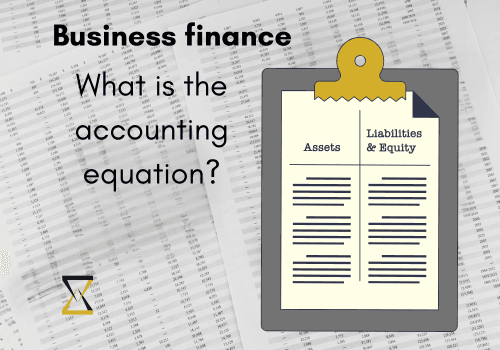
The accounting equation is a method of measuring a business’s value or owner’s equity by evaluating its assets and liabilities. The basic accounting equation uses a simple formula – equity equals assets minus liabilities – to determine a business’s value and profitability.
Investors, co-owners, and other internal or external stakeholders commonly use the accounting equation as a metric for assessing a business’s financial health. The accounting equation also serves as a check on your business’s accounting practices. If every financial transaction has been properly accounted for, both sides of this equation will be equal.
It’s important for entrepreneurs to understand the accounting equation and the components of the accounting equation formula so they can monitor their business’s performance and effectively communicate its value to others.
The basic accounting equation formula and its variables
The accounting equation is an algebraic formula with three components or variables: assets, liabilities and equity. Each of these components can be isolated on either side of the equation by using standard algebraic operations. Most often, though, known asset and liability components are used to calculate the business’s equity.
The accounting equation formula variations with examples
A business has $150,000 in assets while carrying $80,000 in liabilities, resulting in a net value of $70,000.
Equity = Assets – Liabilities (e.g. $70,000 = 150,000 – 80,000)
Assets = Equity + Liabilities (e.g. $150,000 = 70,000 + 80,000)
Liabilities = Assets – Equity (e.g. $80,000 = 150,000 – 70,000)
What are assets, liabilities and equity in the accounting equation?
The values entered into the accounting equation formula will represent all the business’s assets and liabilities, rather than focusing on a single item. Each of your balance sheet entries, such as inventory purchases, capital contributions, accounts payable and receivable, are categorized as assets or liabilities. These categories determine how the amounts affect the accounting equation and your business equity.
Here’s how to identify each of the three components of the accounting equation:
An asset is anything owned or controlled by the company. An item is recorded as an asset even if the business still owes money for its purchase. Assets may include non-physical items such as intellectual property rights or a domain name as well as real property, raw materials or finished goods.
A liability is a debt owed by the company. Liabilities may include money owed for inventory, salaries, or capital expenditures such as a vehicle or building purchase.
Equity is your company’s net value. If you were to sell off all your assets and pay off all the liabilities, equity is what is left.
The expanded accounting equation incorporates more detailed versions of each of these components. These details don’t change the numeric value of the different components but act as notations telling stakeholders or potential investors more about the source of each financial entry.
For instance, assets and liabilities might be categorized as current or long-term or labeled by type. The equity variable might be broken down into categories such as capital contributions and retained earnings.
If you’re using accounting software to maintain your financial statements, this aggregation may happen automatically. Once you’ve entered the details of a transaction, your software will distribute that data into the appropriate accounts and reports.
Comparing the accounting equation formula and double-entry bookkeeping system
The accounting equation formula is sometimes called the balance sheet equation and is commonly associated with double-entry bookkeeping because both processes require financial data to be balanced. The equity side of the equation must equal the assets of the company after subtracting any debts or liabilities.
How does the double-entry bookkeeping system work?
Double-entry bookkeeping applies this balancing process by requiring a debit and credit amount to be entered for each financial transaction. When the debit and credit columns of an entry are combined, the result represents the transaction’s effect on the business’s income or equity.
The calculation formula will look like this:
Credit – Debit = Net Gain or Loss
As new entries are added to the business’s balance sheet, the total net worth or income statement is adjusted to accurately reflect the business’s financial performance.
For example, a $30,000 inventory purchase triggers positive bookkeeping entry of the inventory as an asset. This same purchase also triggers a $30,000 debit entry indicating a reduction in the company’s cash or the assumption of debt to make the purchase. The net effect of this transaction on the owner’s equity is zero. Buying the inventory hasn’t increased the value of the company or its profitability (yet).
However, if the company made a good buy and the inventory’s asset value is $40,000, then the net profit (and the owner’s equity) increases by $10,000. The added value is accounted for on the balance sheet, ensuring accuracy and transparency.
What’s the difference between the accounting equation and double-entry bookkeeping?
The accounting equation and double-entry bookkeeping differ in their purpose and scope. Businesses record financial transactions on a day-to-day basis using the double-entry system while also using the data to inform financial performance metrics. The accounting equation provides a broader overview of the business’s ongoing financial performance.
Using the double-entry bookkeeping system enables business owners and stakeholders to see what they business has acquired and how it was paid for. The accounting equation reveals the effect of that acquisition on the business’s financial position.
Recap: The importance of the accounting equation for entrepreneurs and business owners
You’ve already discovered some of the reasons the accounting equation is important for entrepreneurs and business owners to understand and monitor. But before you go, let me pull all the use cases and their benefits together.
First, the accounting equation serves as a double-check on the accuracy of your financial records. If your total assets and liabilities don’t equal the business’s equity, that signals an error such as a recording error, inaccurate asset valuation or missing funds.
Next, the accounting equation provides high-level insight into your business’s worth as a transferable asset and its viability as a going concern. Negative owner’s equity isn’t always a sign of trouble but it is a risk indicator. Comparing your accounting equation figures year-over-year tells you if your business is growing or shrinking.
Finally, the accounting equation is a fundamental financial principle. Business professionals understand its meaning and expect to see this metric when evaluating an organization’s financial status. Your accounting equation results help you communicate your company’s value effectively to investors and explain equity distributions to stakeholders.
The accounting equation is just one of several methods business owners use to communicate about finances. Check out Aashna Haryani’s article, What is a financial statement? to discover the four main financial statements every entrepreneur should know.
